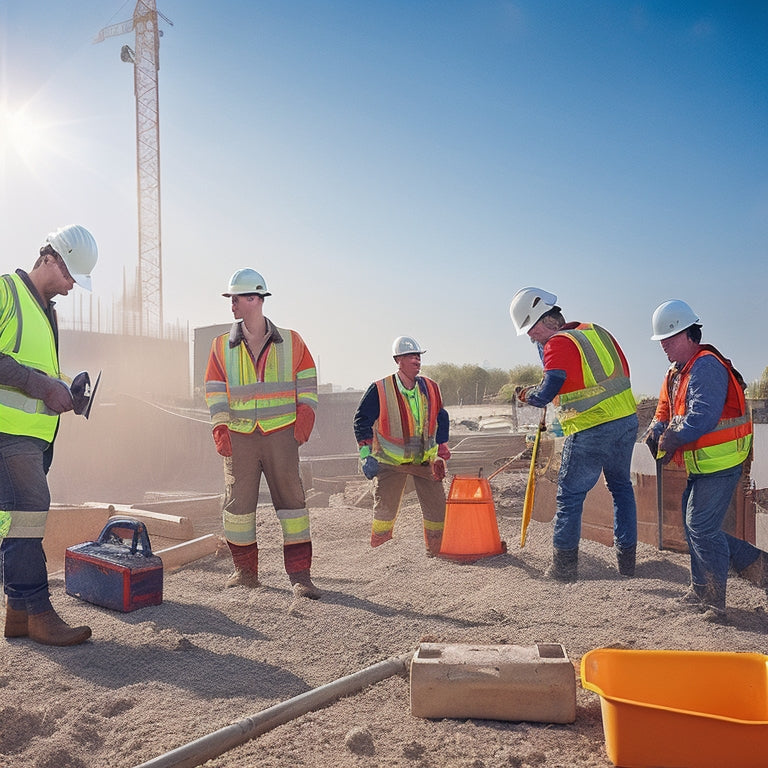
Safety First: Comprehensive Safety Guidelines and Procedures
Share
Implementing thorough safety guidelines and procedures is essential for preventing accidents, maintaining regulatory compliance, and fostering a safety-conscious culture in any organization or workplace. This involves establishing protocols for hazardous materials, equipment, and emergency situations, as well as adhering to standard operating procedures and wearing personal protective equipment. A well-structured safety program also involves proactive hazard identification, risk assessment, and mitigation, as well as regular evaluation and improvement. By integrating these guidelines into daily operations, organizations can guarantee a safe working environment and minimize the risk of accidents. A thorough understanding of these principles is key to creating a safe and healthy work environment.
Key Takeaways
• Implementing standard operating procedures and wearing personal protective equipment ensures a safe working environment.
• Establishing permissible radiation exposure limits and adhering to ALARA procedures ensures radiation safety.
• A safety management program identifies hazards, assesses risks, and mitigates them to prevent accidents and ensure regulatory compliance.
• Handling hazardous materials requires understanding their properties and risks, and implementing proper handling, storage, and disposal procedures.
• Building safety protocols include guidelines for corrosive baths, office safety, fire doors, and flammable liquids to prevent accidents and ensure compliance.
Safety Guidelines and Procedures
Safety guidelines and procedures are crucial in guaranteeing a safe working environment. This section outlines the protocols for handling hazardous materials, equipment, and emergency situations.
Effective lab safety protocols involve following standard operating procedures, wearing personal protective equipment (PPE), and maintaining a clean and organized workspace. PPE includes gloves, goggles, and lab coats that protect against chemical splashes, spills, and other hazards.
Additionally, regular training and drills prepare personnel to respond promptly and effectively in emergency situations. By following these guidelines and procedures, individuals can minimize the risk of accidents and establish a safe working environment.
Radiation and Chemical Safety
Moreover, permissible radiation exposure limits for employees are established to minimize health risks, and adherence to ALARA (As Low As Reasonably Achievable) procedures is essential for ensuring a safe working environment. Employees working with radiation-producing machines must comply with these limits to prevent radiation-induced illnesses.
In addition, the use of chlorine compounds as disinfectants requires careful handling and disposal. Disinfectant substitutes should be explored to minimize exposure risks. Safe handling procedures for hazardous chemicals, such as hydrofluoric acid, must be followed to prevent accidents.
Moreover, radiation and chemical safety guidelines must be integrated into daily operations to protect employees and prevent environmental contamination. By following these guidelines, employees can minimize their permissible exposure to radiation and chemicals, ensuring a safer working environment.
Safety Program Management Essentials
Effective research institutions establish and maintain a thorough safety management program, comprising essential elements and clear responsibilities, to guarantee a proactive approach to hazard identification, risk assessment, and mitigation.
A well-structured safety program ensures that all personnel are aware of their roles and responsibilities in maintaining a safe working environment.
Key elements of a safety program include safety program evaluation, which involves regular assessments to identify areas for improvement, and safety culture development, which fosters a culture of accountability and open communication.
Principal Investigators play an important role in ensuring compliance with safety protocols and promoting a safety-conscious culture within their research groups.
Hazardous Material Handling Protocols
Managing hazardous materials requires a thorough understanding of the distinct properties and risks associated with each substance to guarantee proper handling, storage, and disposal procedures are implemented.
This includes pyrophoric and water-reactive reagents, formaldehyde, and dichloromethane, which demand specialized handling protocols. Effective chemical spill response and safety training are essential to mitigate potential risks.
Hazardous waste disposal must be carried out in accordance with regulatory guidelines to prevent environmental harm. Spill containment measures, such as secondary containment and absorbent materials, should be in place to prevent the spread of hazardous substances.
Building Safety and Compliance
Building safety guidelines encompass a range of critical protocols, including those for corrosive baths, office safety, fire doors, flammable liquids, and fire protection systems, all of which are essential for preventing accidents and ensuring regulatory compliance. Regular building inspections are vital to identify potential hazards and confirm that all safety measures are in place.
Fire safety regulations, in particular, must be strictly adhered to, including the proper installation and maintenance of fire alarms, sprinkler systems, and fire extinguishers. Additionally, evacuation routes and emergency response plans must be clearly communicated to all occupants.
Frequently Asked Questions
What Is the Protocol for Reporting Near-Miss Incidents in the Workplace?
The protocol for reporting near-miss incidents involves prompt Incident Analysis to identify root causes, followed by Anonymous Reporting to encourage open disclosure, ensuring a thorough understanding of the incident to prevent future occurrences.
How Often Should Employees Review and Update Their Safety Training Certifications?
According to OSHA, every 12 seconds, a worker is injured on the job. To mitigate this, employees should review and update their safety training certifications every 6-12 months to guarantee compliance with regulations and maintain certification validity.
Are There Any Safety Resources Available for Remote or Off-Site Workers?
Remote workers can access Virtual Checkpoints, a digital platform offering safety resources, training, and Solo Support, ensuring they stay informed and compliant with safety protocols, even when working off-site.
What Is the Process for Requesting a Safety Audit or Risk Assessment for a Specific Area?
To request a safety audit or risk assessment, prepare by identifying areas of concern and gathering relevant data. Submit a formal request to the safety department, outlining the scope and objectives, and allowing sufficient time for risk identification and audit preparation.
Can Safety Guidelines Be Temporarily Waived for Exceptional Circumstances or Emergencies?
In exceptional circumstances or emergencies, safety guidelines may be temporarily waived through Emergency Exemptions, which allow for Regulatory Flexibility, ensuring prompt response while minimizing risks, under the condition of thorough justification and approval from authorized safety personnel.
Related Posts
-

Wall-Mounted Shelves for Bathroom Organization
Wall-mounted shelves can completely alter your bathroom into an organized oasis. By maximizing vertical space, you cr...
-

Stylish Glass Door Storage Solutions
Stylish glass door storage solutions transform your spaces into stunning showcases. These sleek designs maximize spac...
-

Kitchen Remodeling Made Easy: Free Planning Tools
I'm excited to transform my kitchen into a stunning space, but I know that without a clear plan, my dream can quickly...


